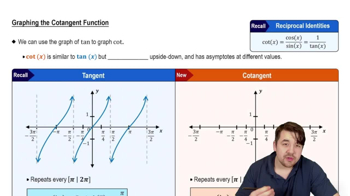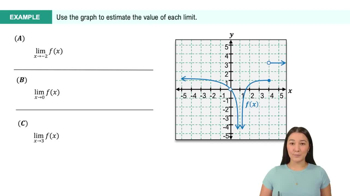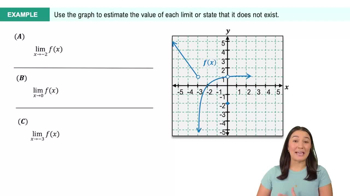Table of contents
- 0. Functions7h 52m
- Introduction to Functions16m
- Piecewise Functions10m
- Properties of Functions9m
- Common Functions1h 8m
- Transformations5m
- Combining Functions27m
- Exponent rules32m
- Exponential Functions28m
- Logarithmic Functions24m
- Properties of Logarithms34m
- Exponential & Logarithmic Equations35m
- Introduction to Trigonometric Functions38m
- Graphs of Trigonometric Functions44m
- Trigonometric Identities47m
- Inverse Trigonometric Functions48m
- 1. Limits and Continuity2h 2m
- 2. Intro to Derivatives1h 33m
- 3. Techniques of Differentiation3h 18m
- 4. Applications of Derivatives2h 38m
- 5. Graphical Applications of Derivatives6h 2m
- 6. Derivatives of Inverse, Exponential, & Logarithmic Functions2h 37m
- 7. Antiderivatives & Indefinite Integrals1h 26m
- 8. Definite Integrals4h 44m
- 9. Graphical Applications of Integrals2h 27m
- 10. Physics Applications of Integrals 2h 22m
1. Limits and Continuity
Introduction to Limits
Problem 2.5.61
Textbook Question
Determine the end behavior of the following transcendental functions by analyzing appropriate limits. Then provide a simple sketch of the associated graph, showing asymptotes if they exist.
 Verified step by step guidance
Verified step by step guidance1
Step 1: Understand the function f(x) = sin(x). The sine function is periodic with a period of 2π, meaning it repeats its values every 2π units along the x-axis.
Step 2: Analyze the range of the sine function. The sine function oscillates between -1 and 1 for all x, so its range is [-1, 1].
Step 3: Determine the end behavior by considering the limits as x approaches positive and negative infinity. Since sin(x) is periodic and bounded, it does not approach a specific value as x approaches infinity or negative infinity.
Step 4: Identify any asymptotes. The sine function does not have any vertical or horizontal asymptotes because it is bounded and periodic.
Step 5: Sketch the graph of f(x) = sin(x). Draw a wave-like pattern oscillating between -1 and 1, repeating every 2π along the x-axis, with no asymptotes.
 Verified video answer for a similar problem:
Verified video answer for a similar problem:This video solution was recommended by our tutors as helpful for the problem above
Video duration:
12mPlay a video:
Was this helpful?
Key Concepts
Here are the essential concepts you must grasp in order to answer the question correctly.
End Behavior of Functions
End behavior refers to the behavior of a function as the input values approach positive or negative infinity. Understanding end behavior is crucial for analyzing limits and determining how a function behaves at its extremes. For example, knowing whether a function approaches a specific value, diverges, or oscillates helps in sketching its graph accurately.
Recommended video:

Graphs of Exponential Functions
Limits
Limits are fundamental in calculus, representing the value that a function approaches as the input approaches a certain point. They are essential for understanding continuity, derivatives, and integrals. In the context of transcendental functions like sine, limits help determine the function's behavior at infinity, which is vital for analyzing end behavior.
Recommended video:

One-Sided Limits
Asymptotes
Asymptotes are lines that a graph approaches but never touches, indicating the behavior of a function as it extends towards infinity. They can be vertical, horizontal, or oblique, depending on the function's characteristics. Identifying asymptotes is important for sketching graphs accurately, especially for functions that exhibit unbounded behavior or oscillation.
Recommended video:

Introduction to Cotangent Graph

 6:47m
6:47mWatch next
Master Finding Limits Numerically and Graphically with a bite sized video explanation from Callie
Start learning




